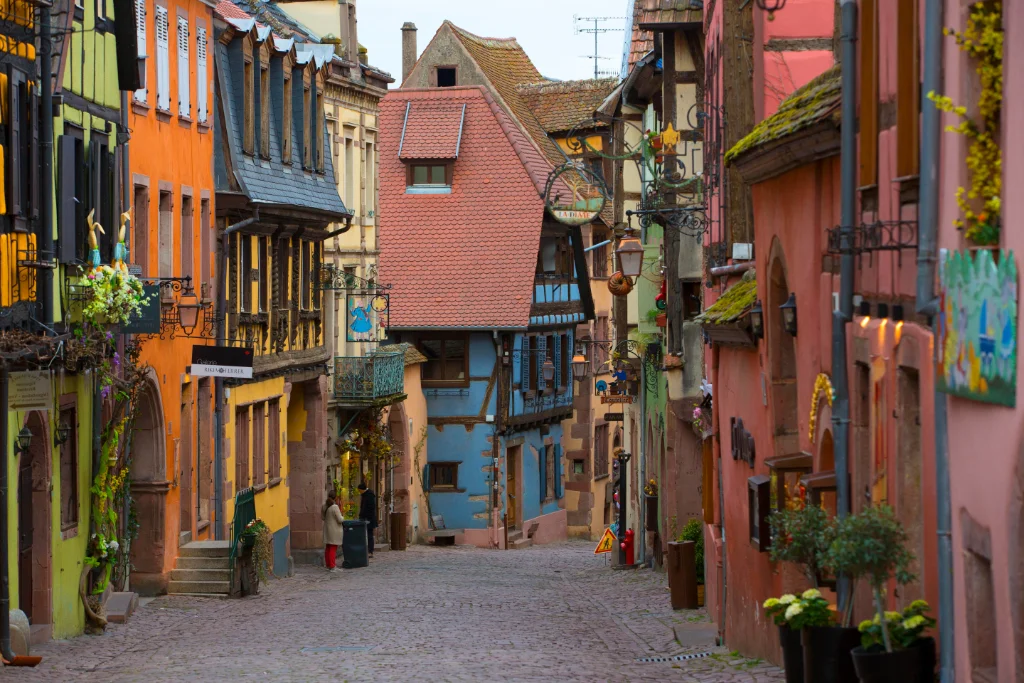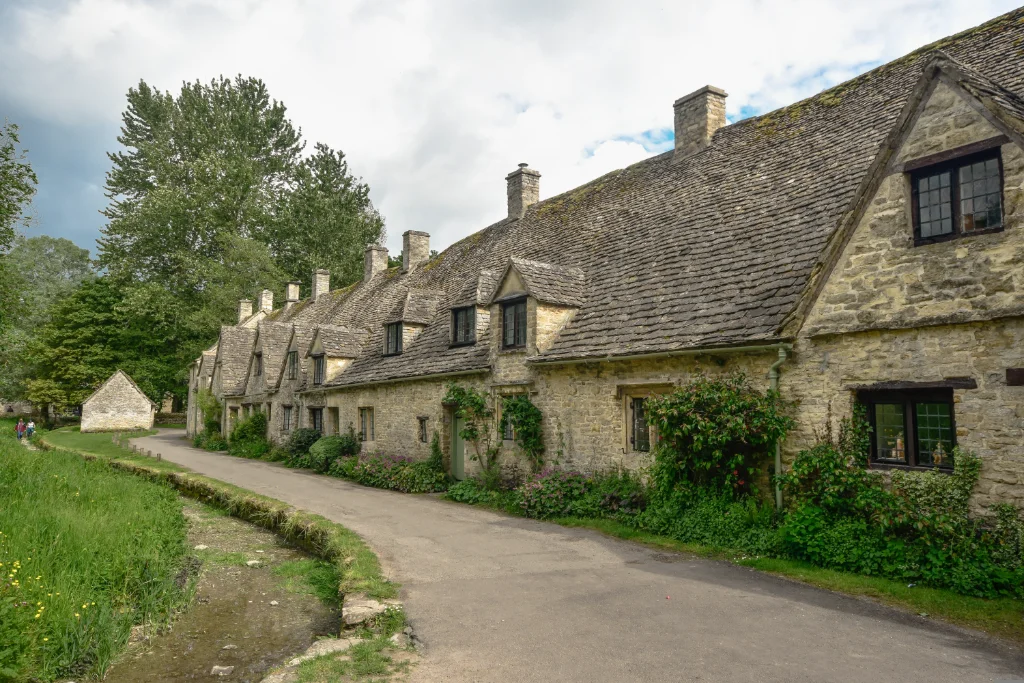Bibury is one of the most Beautiful villages in England.
Famous for its traditional stone cottages and tranquil rural setting, Bibury offers a perfect snapshot of the English countryside that has enchanted visitors and photographers from around the world.
This charming village, once described by artist William Morris as “the most beautiful village in England,” provides a timeless escape into a landscape filled with lush meadows, meandering streams, and historic architecture.
As you stroll through Bibury, the quintessential Cotswold stone buildings and well-preserved heritage tell tales of a bygone era, harmoniously blending with the natural beauty of the Gloucestershire countryside.
Ideal for those seeking serenity or a touch of historical exploration, Bibury invites its visitors to step back in time and experience the slower pace of village life.
Whether you want to explore its famous landmarks like Arlington Row, unwind by the River Coln, or simply soak in the atmosphere of this idyllic locale, Bibury promises a memorable journey into the heart of rural England.
Where is Bibury Located ?
Bibury is located in Gloucestershire, England, within the Cotswolds, an Area of Outstanding Natural Beauty.
The village is about 83 miles (134 kilometers) west of London and around 15 miles (24 kilometers) from Cheltenham.
Bibury is situated at an altitude of 131 feet (40 meters) above sea level, along the River Coln.
It is also close to Cirencester, just 7 miles (11 kilometers) to the southeast, making Bibury a convenient point for exploring the Cotswolds region.
This location allows easy access to the scenic landscapes and other small towns of the Cotswolds.
How to Travel to Bibury ?
1. By Car:
If you’re coming from London, you can take the M4 Motorway, exit at junction 15 towards Cirencester (A419), and then continue on the B4425 directly to Bibury.
This route is about 1 hour and 30 minutes long.
For those coming from the North via the M5, exit at junction 11A and follow the same route from Cirencester.
2. By Train:
The nearest train station to Bibury is Kemble, located about 14 miles away.
From Kemble, you can take a taxi to Bibury, which typically costs around £25 and takes approximately 26 minutes.
There are bus services provided by Pulhams Coaches from Oxford to Bibury, which involve a transfer at Market Square.
The journey takes about 3 hours and 39 minutes, and ticket prices range from £9 to £15.
The buses run twice daily from Oxford to Bibury, making it a viable option for those preferring public transport.
Cost-Effective Traveling Tips
- Try Visiting during weekdays or outside the main tourist seasons, when travel and accommodation rates are lower.
- Utilize buses or trains rather than taxis or car rentals.
- The bus service from Oxford to Bibury is an affordable choice that offers a scenic entry into the countryside.
- Secure travel and accommodation early to take advantage of better rates and availability, particularly during tourist seasons.
- Opt for local diners and markets instead of tourist-oriented restaurants to enjoy lower meal prices.
- If possible, travel in a group to share costs like taxi fares and take advantage of group discounts on tours and accommodations.
Discover Bibury :
1. What is the history of Bibury ?
Bibury, often hailed as the most beautiful village in England, is steeped in history that dates back to its founding in the Middle Ages.
The village is mentioned in the Domesday Book of 1086, which underscores its long-standing significance in the Cotswolds region.
Historically, Bibury was a thriving wool town, and this heritage is especially reflected in the 17th-century weaver’s cottages at Arlington Row, one of the village’s most photographed scenes.
In the 19th century, Bibury caught the eye of the artist and craftsman William Morris, who declared it the most beautiful village in England, a sentiment that has only fueled its fame.
Today, Bibury’s historical charm is preserved in its architecture and layout, which continue to draw visitors from around the world, captivated by its timeless appeal and the gently flowing River Coln that meanders through the village.
This deep-rooted history is not only a testament to the village’s past but also a cornerstone of its current status as a quintessential English village, attracting those who wish to experience a slice of England’s rich cultural heritage.
For further reading on Bibury’s history, you can check out detailed articles and historical insights at Britain Express and British History Online, which provide comprehensive backgrounds on the village’s past and its evolution through the centuries.
2. How is the Weather Like Throughout the Year in Bibury ?
Bibury experiences a temperate maritime climate, typical for much of the UK, with distinct seasons offering a variety of weather conditions suitable for different activities.
The winter months (December through February) in Bibury are generally cool, with average temperatures hovering around 2°C to 8°C.
During this time, it’s not uncommon to experience frosty mornings and occasional snowfall, creating beautiful winter scenes, especially around Arlington Row.
The spring season (March through May) sees a gradual warming, with temperatures ranging from 6°C to 15°C.
This season is marked by the blooming of daffodils and crocuses, making it a beautiful time for walks through the village and countryside.
Summer (June through August) in Bibury is relatively warm and the most popular time for tourists.
Temperatures usually range from 15°C to 22°C, providing ideal conditions for exploring the outdoors, participating in local festivals, or simply enjoying the scenic beauty of the Cotswolds.
Autumn (September through November) brings cooler temperatures and a magnificent display of changing foliage, with averages between 11°C and 17°C.
This time of year is perfect for photographers and nature enthusiasts looking to capture the vibrant autumn colors that decorate the landscape.
Rainfall is fairly distributed throughout the year, with October often being the wettest month.
Visitors should always be prepared for sudden changes in weather and carry appropriate rain gear when exploring the area.
For those planning a visit, checking current conditions and seasonal weather forecasts on reliable platforms like BBC Weather or Met Office is recommended to ensure an enjoyable and comfortable trip.
3. How is the geography like in Bibury ?
The village itself is situated along the River Coln, a tributary of the Thames, which adds to the area’s charm with its clear, flowing waters.
The geography of Bibury is marked by the typical Cotswold stone used in much of its architecture, enhancing its quaint and rustic feel.
The terrain around Bibury includes gently rolling hills, which are part of the larger Cotswold hills, known for their distinctive limestone grassland.
This topography is ideal for walking and enjoying the natural scenery, making Bibury a popular destination for outdoor activities.
The village’s elevation varies, providing different viewpoints from which to appreciate the lush English countryside.
The surrounding area includes notable features like Arlington Row, one of the most photographed examples of traditional Cotswold stone cottages, and Ablington Manor, adding historical depth to the landscape.
These elements make Bibury not just a visual treat but also a place of significant geographical and historical interest.
4. What Type of clothing is recommended for visiting Bibury ?
- Given the variability in weather, layering your clothing allows for easy adjustments throughout the day.
Lightweight layers are ideal for the warmer months, while heavier layers like sweaters and jackets are necessary during colder months. - A waterproof jacket is essential, especially if you’re visiting during the rainy months (October is typically the wettest). This will help keep you dry during unexpected showers.
- Since Bibury is best explored on foot, and the terrain includes cobbled streets and countryside paths, sturdy and comfortable walking shoes are a must.
- On sunny days, don’t forget to bring sunglasses, a hat, and sunscreen, especially if you plan to spend a lot of time outdoors.
- An umbrella can be handy for sudden weather changes, ensuring you can continue exploring regardless of rain.
6 Tips to Find a Local Guide in Bibury :
Finding a knowledgeable guide can significantly enhance your experience in Bibury.
Here are some tips to help you find a local advisor:
Start at the Bibury Tourist Information Center, where you can get recommendations for certified local guides who specialize in various tours, including historical walks and nature explorations.
2. Ask Your Accommodation :
Many hotels and B&Bs in Bibury, such as the Swan Hotel, often have partnerships with local guides and can arrange tours for their guests.
They can recommend guides who have a good reputation and provide exceptional service.
3. Online Platforms :
Websites like TripAdvisor and Viator are useful for finding and booking local guides.
These platforms offer reviews and ratings from previous tourists, which can help you choose a guide who best fits your interests.
4. Ask for Recommendations on Social Media :
Utilize platforms like Facebook or Instagram by joining travel groups or forums focused on the Cotswolds area.
Members often share their experiences and can recommend guides they have used in the past.
5. Visit Local Attractions :
Places like Arlington Row or Bibury Trout Farm often have connections to tour guides or may offer their own guided tours.
Asking the staff can lead you to trusted guides who are familiar with the attractions.
6. Consider Community Boards and Flyers :
Keep an eye out for flyers and notices in community spaces like cafes, libraries, or the village hall.
Local guides might advertise their services through these traditional methods.
7 Must-Do Activities in Bibury :
1. Visit Arlington Row :
As one of England’s most iconic postcard scenes, Arlington Row features a beautiful set of cottages dating back to the 17th century.
Originally built as a wool store and later converted into weavers’ cottages, these structures represent traditional Cotswold architecture.
Visiting here is free, and you can wander any time, though early mornings or late afternoons offer quieter moments to enjoy the serene ambiance.
2. Explore Bibury Trout Farm :
Established in 1902, the Bibury Trout Farm is one of England’s oldest working trout farms.
Visitors can engage in feeding the fish, catching their own trout, or simply enjoying the lush surroundings.
The farm is open daily with an entrance fee of around £4.50 for adults, providing a fun and interactive experience for all ages.
3. Stroll by the River Coln :
The River Coln flows through Bibury, offering scenic paths perfect for leisurely walks.
The river adds to the village’s charming view, making it a great spot for photography or a relaxing picnic.
4. Discover St. Mary’s Church Architectural Beauty :
This historic church represents a significant part of Bibury’s heritage.
Visitors can admire its architectural beauty and explore the peaceful churchyard.
It’s open to visitors throughout the year without any entrance fee, allowing everyone to appreciate its tranquil beauty and architectural details.
5. Shop for Local Crafts :
Bibury is also a great place to shop for unique local crafts and souvenirs.
From handwoven baskets to locally made jams and artisan crafts, the shops in Bibury offer a variety of goods that reflect the artistic talent of the Cotswolds.
6. Hike in Bibury (Cotswold countryside) :
Bibury is a prime spot for hiking, offering several trails through the stunning Cotswold countryside.
Here’s a quick guide to some of the local favorites:
Bibury and Ablington Circular :
This 5.2-mile loop trail takes around 2 hours to complete.
It’s moderately challenging and less crowded, ideal for those seeking a peaceful hike.
The trail is most enjoyable from August to October.Arlington Row – Bibury Loop :
An easy trail suitable for all ages and fitness levels, starting right from Bibury.
It features beautiful views of Arlington Row and the River Coln, perfect for a family outing.Bibury, Quenington, and Coln St Aldwyns Circular :
Covering 8.4 miles, this trail takes about 3 hours and 32 minutes to finish.
It offers a more challenging hike through Bibury and nearby villages, showcasing the area’s unique landscapes and historical sites.
Interested in hiking around Bibury? Visit This Link to explore the best hiking paths.
7. Experience Local Festivals in Bibury :
Bibury hosts several unique festivals throughout the year, each offering visitors a taste of local culture and tradition. Here are some notable events:
Bibury Duck Race:
Held annually on Boxing Day (December 26th), the Bibury Duck Race is a charming and quirky event that has been a tradition for over 35 years.
The race takes place along the River Coln, which flows through the village.
It attracts hundreds of locals and tourists, who gather to watch thousands of plastic ducks race down the river.
The event is free to watch, and small fees apply if you want to sponsor a duck.
This beloved tradition not only provides festive entertainment but also raises funds for local charities.BibLit:
Bibury also hosts a literary festival known as BibLit.
This event focuses on biographies and features a day of talks and discussions by various authors.
The festival is typically held once a year, with ticket options ranging from single-session passes to full-day access.
Prices and exact dates vary each year, so checking the Bibury Festivals website is recommended for the latest details.
6 Unique Crafts and Products in Bibury:
1. Handwoven Baskets and Textiles :
Bibury is home to skilled artisans who produce beautifully handwoven baskets and textiles, using traditional techniques that have been passed down through generations.
These items often feature intricate designs and are made from local materials, reflecting the natural beauty of the Cotswolds.
2. Local Honey and Jams :
The village and its surrounding areas are known for producing high-quality, natural honey and jams.
These products are made from locally sourced fruits and flowers, offering a taste of the region’s rich floral diversity.
3. Cotswold Lavender :
Items infused with Cotswold lavender are popular in Bibury.
From essential oils and scented candles to soaps and lotions, these products not only smell wonderful but also make great gifts.
4. Leather Goods :
There are craftsmen in Bibury who specialize in creating fine leather goods, including belts, bags, and wallets.
These items are known for their durability and classic style, crafted using traditional methods.
5. Ceramics :
Local potters produce a range of ceramic goods that are both functional and decorative.
Visitors can find everything from hand-painted plates and mugs to bespoke pottery pieces, each uniquely showcasing the artisan’s skill.
6. Prints and Paintings :
Local artists capture the charming views of Bibury and the Cotswolds in their prints and paintings.
These artworks are available at various galleries and shops throughout the village, offering visitors a chance to take home a piece of Bibury’s scenic appeal.
3 Signature Dishes and Restaurant Recommendations in Bibury :
1. The Catherine Wheel :
Located on Arlington Row in Bibury, this pub offers classic English dishes such as Ploughman’s Lunch and Sunday Roasts, complemented by a selection of local ales.
2. The Swan Hotel :
Situated in the heart of Bibury, The Swan Brasserie specializes in dishes like Cotswold lamb and seasonal vegetable tarts, crafted with locally sourced ingredients.
3. Bibury Trout Farm Café :
Found within the grounds of Bibury Trout Farm, this café is celebrated for its trout dishes, alongside a variety of sandwiches and salads, perfect for a lighter meal.
6 Essential Tips you Need To Know Before Visiting Bibury :
- Plan Your Visit:
Check the opening hours of key attractions like Arlington Row and Bibury Trout Farm as they may vary seasonally. - Dress Appropriately:
Weather can be unpredictable, so bring layers and waterproof clothing to adapt to sudden changes. - Parking:
Parking can be limited, especially on weekends and holidays. Arrive early or visit during off-peak hours to find parking more easily. - Respect Local Etiquette:
Bibury is a quiet, residential village.
Maintain a respectful noise level and dispose of litter properly. - Photography:
While photography is welcomed, be considerate of private properties and do not obstruct pathways. - Walking Shoes:
Comfortable walking shoes are a must for exploring the village and nearby trails.
3 Other Attractions Near Bibury :
Bibury serves as a gateway to various captivating attractions within and around the Cotswolds, making it an ideal base for exploring more of this beautiful region:
Often referred to as the “Capital of the Cotswolds,” Cirencester is just a 15-minute drive from Bibury.
This historic Roman town offers a range of attractions, including the Corinium Museum, which houses one of the largest collections of Romano-British antiquities in the UK.
About 20 minutes from Bibury, Burford is a medieval town with a high street sloping down to the River Windrush, lined with ancient houses and quaint shops. It’s perfect for those who enjoy exploring historical architecture and local boutiques.
Located approximately 40 minutes from Bibury, this UNESCO World Heritage Site offers a stunning example of English Baroque architecture set within over 2,000 acres of parkland.
The palace is famous for being the birthplace of Winston Churchill.
FAQs: Top 8 Most Asked Questions About Bibury :
The best time to visit Bibury is during spring (March to May) and early autumn (September to October) for pleasant weather and fewer crowds. However, the village looks beautiful in all seasons, with each offering a unique charm.
Bibury is famous for its historic cottages at Arlington Row, which are a notable example of 17th-century Cotswold architecture.
The village is set within the beautiful landscape of the Cotswolds, attracting photographers and history enthusiasts.
You can explore Arlington Row, visit the Bibury Trout Farm, walk along the River Coln, and have lunch at the local pub.
Visiting St. Mary’s Church or having afternoon tea are also popular activities.
Absolutely! Bibury is often described as one of the most beautiful villages in England.
Its beautiful streets, historical buildings, and natural surroundings offer a typical English country experience.
The village’s atmosphere is perfect for those looking to step back in time and enjoy the tranquility of rural England.
Parking is available along the main street and there’s a small free parking area near the Trout Farm.
It’s advisable to arrive early during busy periods to secure a spot.
Bibury has been used as a film location for its typical English village scenery, including for scenes in the film “Stardust.”
The postal code for Bibury varies with different areas, but for the Trout Farm, it is GL7 5NL.
The Catherine Wheel is a well-known pub in Bibury offering local ales and pub food in a friendly setting.
5 General Safety Tips for Visiting Bibury :
- Always remember the emergency number in the UK is 999, connecting you to police, fire, and medical services.
- Check the weather forecast regularly and be prepared for sudden changes; carry suitable clothing and rain gear.
- Drive carefully on narrow and winding roads, particularly on single-track roads where visibility may be limited.
- Adhere to local rules at attractions, such as restrictions on photography, feeding wildlife, or accessing certain areas.
- Keep your valuables secure, especially in crowded tourist spots, to avoid potential theft.
- Maintain a respectful distance from wildlife to protect both the animals and their natural habitat.
- Know the location of the nearest hospital or medical center; local tourist information centers can provide this if needed.





